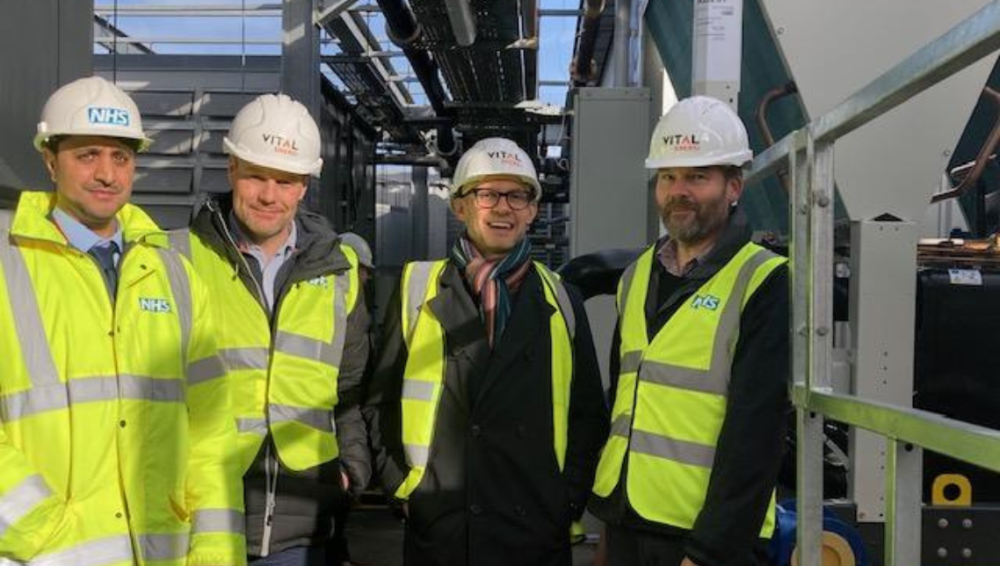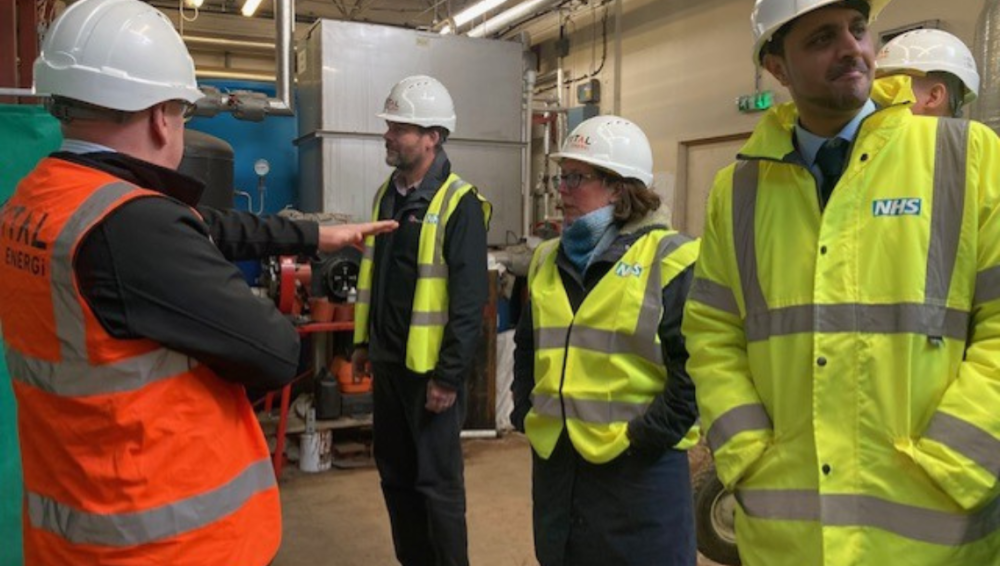Top team puts net zero work at leading Oxfordshire hospital site under the spotlight

Our very own Salix chief executive and board chair join hospital executives and government representatives for tour of a Public Sector Decarbonisation Scheme project
Chair of Salix board Baroness Natalie Evans and chief executive Kevin Holland spent the day at John Radcliffe Hospital, home to Oxfordshire's main A&E site and acute hospital services.
They were joined by representatives from the Department for Energy Security and Net Zero including Rob Hewitt, director, Industrial Decarbonisation and Emissions Trading and Paul Chambers, deputy director, public sector decarbonisation. Also joining was Salix’s director of public sector decarbonisation Ian Rodger.
Hosted by hospital and project representatives they were able to get a close up look of the highly ambitious work.
Everyone was interested to see how funding from the government run Public Sector Decarbonisation Scheme was being delivered on site.
Baroness Natalie Evans of Bowes Park said: “It was very useful to see in practice how projects of this scale come together and how the work at the John Radcliffe Hospital is part of a bigger ongoing project at OUH.
It was clear to see the impact of strong and collaborative stakeholder relationships in developing the vision as well as delivering these kinds of projects. The working relationship between the hospital and its delivery partners has driven the decarbonisation works forward and will continue to do so as the project progresses
Salix chief executive, Kevin Holland, added:
It’s fascinating to see projects on this scale - it shows the positive impact from delivery teams at both Salix and the Department for Energy Security and Net Zero.
Oxford University Hospitals NHS Foundation Trust (OUH) has taken a giant step forward to meeting its Green Plan objectives thanks to funding under the Public Sector Decarbonisation Scheme.
The net zero works at John Radcliffe Hospital are aimed at making the hospital more energy efficient as well as providing a better environment for patients. The work is expected to complete by the end of the year.
A total of £24.1m was awarded to the John Radcliffe and £5.7m to Horton General under Phase 3b of the Public Sector Decarbonisation Scheme. The scheme is run by the Department for Energy Security and Net Zero to support the aim of reducing emissions from public sector buildings.
Oxford University Hospitals NHS Foundation Trust (OUH) contributed £8.2m towards the wider scheme, taking the total expenditure to £38m over a three-year period.
Understanding the project
During their tour guests were joined by hospital head of OUH’s facilities and estates operations Jeenash Mistry, Mark Holloway, chief estates and facilities officer, Wendy Cheeseman, head of sustainability and carbon management and Craig Merrifield, deputy director of capital development. They talked about the Trust’s vision for the net zero future as well as the complexities of how project work was steered on a large hospital site.
Also joining was the Vital Energi team, the prime contractors for the project. The team included Steve Black, account director, Chris Yeo, director of low carbon solutions, Neil Otter, senior project manager and Jordan Firth, contracts manager who were able to explain the technologies being installed.
Jeenash said: “We have achieved a huge amount and it’s been a highly complex project; we cannot just turn the power off and get on with work. This is a hospital and at no point have patient services been impacted.
“Resilience is very much part of our discussion.”
Steve added: “The first priority here is to the patients and the people who use this hospital, then it is address the carbon emissions and then working as a team between ourselves, the Trust, the hospital, the Department and Salix.”
As one of our largest NHS trusts, the project has set a positive example to others to navigate the journey and learn from the work at the John Radcliffe.
Mark said: “We are future proofing the hospital and we have a long way to go on our journey, but we have a good example here of what can be achieved, but this is just the start.”
The project tour and technologies
The group looked at the new energy efficiency technologies including the energy efficient fans in air-handling units, building management systems, plate heat exchangers, the new low-temperature-hot-water pipework distribution system and cascading air-to-water heat pumps.
The project involves the John Radcliffe Hospital and Horton hospitals being 'de-steamed', with the existing steam network decommissioned and replaced with new, cleaner, and more efficient pipework. The pipework is heated by substituting gas boilers with low carbon electric heat pumps and additional energy efficiency measures.
At Horton General Hospital, zero carbon technologies were connected into the existing low temperature heating system.
In addition to improving the efficiency through heat pumps, the new system also reduces carbon emissions and the carbon footprint, water consumption, water treatment costs, operational and maintenance costs and reduces the Trust's maintenance backlog by replacing end-of-life infrastructure in buildings.
Solar panels, more efficient pipework insulation, and draught proofing, have also been installed to improve energy efficiency.
OUH is one of the UK’s largest acute teaching NHS Trusts. It works in close partnership with the University of Oxford, and is a leading centre for cancer, neurosciences, diabetes and genetics - among other fields.
Jeenash explained: “We are very ambitious for the site. The modernisation of the building’s heating and hot water infrastructure will improve our energy efficiency by adapting a range of low carbon technologies.
“It is something we have to do, it’s not as simple as just putting in a heat pump there is a lot of work involved in connecting the systems, moving equipment as well as communicate to everyone here what is happening and when.
“The Public Sector Decarbonisation Scheme has been fundamental in supporting our journey towards the national target for a net zero NHS carbon footprint by 2040.”
Kevin added: “We are looking forward to seeing the positive impact the hospital has with these works and how this ultimately delivers benefits for patients, employees and hospital visitors - as well as for the community it serves.
“It’s a privilege for us at Salix to support such vital work.”






